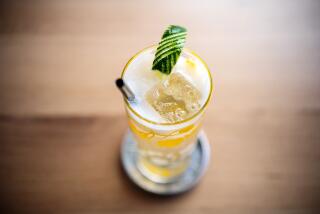Dry Cuisine
- Share via
The prohibition of alcohol in the ‘20s wreaked vast changes in American dining. Many French restaurants closed down rather than try to cook without wine. In the Bathtub Gin age, fashionable people no longer went out for a fine French meal anyway--the new ideal was the “cute little hole in the wall” serving what we’d now call ethnic food.
If you wanted to make a recipe that called for wine, you could use vinegar, bottled Concord grape juice or special “cooking wine,” which had been salted with the idea that this would keep people from drinking it. You only have to look at one recipe for sole Marguery using Concord grape juice to see why the French restaurants closed in disgust.
Of course, at home you could use real wine. There was bootleg wine for sale, and it was actually legal to make up to 200 gallons of wine for your own use.
Unfortunately, nearly all Prohibition-era grapes made low-grade “red ink” with plenty of color but little flavor. The main reason people drank it was that it was considered safer than the so-called gin and whiskey of the time. So when the prohibition laws were repealed, the market for table wine instantly collapsed. Until the ‘60s, American winemakers survived mostly by making cheap sweet wines such as “port,” “sherry,” “Tokay,” ????QUOTES CQ? muscatel and the now-forgotten angelica.
Prohibition also affected the American taste in beer. Basically, it just about killed off the ale-drinking tradition. The commercial breweries that survived Prohibition were the ones that specialized in lager beer, which requires refrigeration, because they’d been able to weather Prohibition by processing foods.


